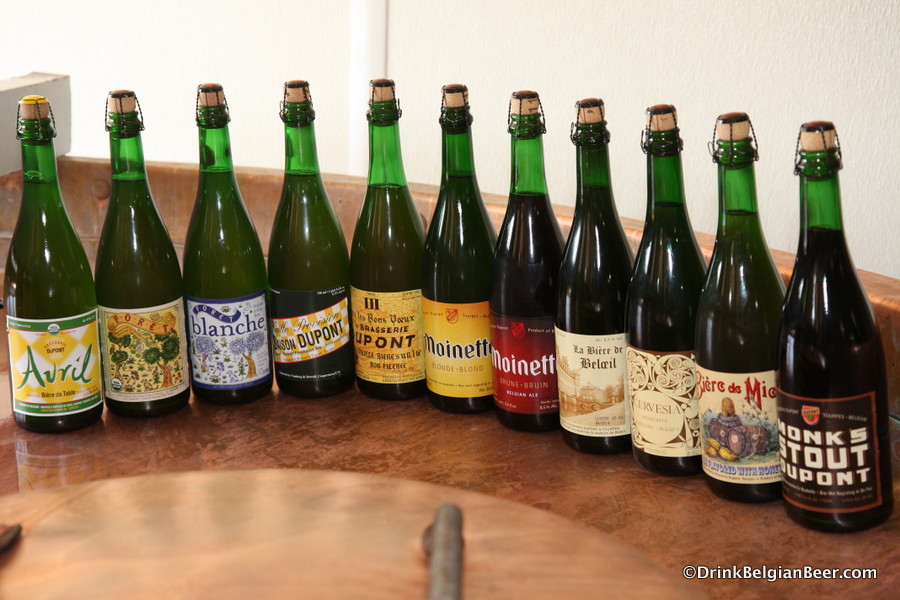Cervesia was created in 1983 on the request of an Iron Age archaeological site, near the brewery, Archéosite d’Aubechies.
The site is a living museum dating back 5,000 years, with exhibitions of life dating from the Iron Age to the Gallo-Roman era. A Belgian researcher, André Allard, husband of Claude Rosier, studied Gallo-Roman drinks of the time, including beer. He isolated many of the ingredients used in beer produced locally in that era. The ingredients used in making Cervesia are largely based on his research. In those times, hops were not a common ingredient in beer.

This being Belgium, the museum wanted a beer to showcase to visitors what ancient brews might have tasted like. While it’s unlikely that these pre-modern era brews achieved the 8% abv that Cervesia has, no matter. This unique beer, which has very little hop content (by Belgian law, beer must contain at least a minimal amount of hops to be legally called a beer) is the best gruit beer I have ever tasted. It is not too sweet, and hides it alcohol well, something the Dupont brewery masters.
Vanberg and DeWulf are also importing La Bière de Belœil, an amber beer of 8.5%, for the first time. This brew was created on the request of the village of Belœil, which is known for its Château de Belœil, a beautifully preserved 17th century château. Earlier structures dated back eight centuries. The Princes of Ligne, local nobility that were very prominent in Belgium’s history, have inhabited the site for hundreds of years.

Photo: courtesy Chateau de Beloeil
Château de Belœil is a major tourist attraction in the area, and its grounds cover an area of about 60 acres. In fact, a major classical musical fest is held every August. About 15,000 people attend the event, watching live performances on many stages. The French gardens on the grounds are very impressive.

Photo: La Bière de Belœil, on top of a table said to have been owned by Napoleon’s assistant. The table is located in “The Field Marshal’s Parlor” at Château de Belœil, Hainaut Province.
Naturally, as this is Belgium, they have a house beer brewed to offer for sale to visitors. They don’t call Belgium “The Beer Country” for nothing! In fact, there used to be a brewery on site, which made a beer called Saison Roland. It is since gone, so Bière de Belœil was created in 1988. It has five different types of malts in its recipe. It is a fruity, malty, yeasty, with an aromatic hop character. Bière de Belœil brings the total number of Dupont beers imported to the U.S. to a dozen.
As far as Dupont’s newest beers, Olivier Dedeycker told me: “My plan is to recreate some of the beers that my grandfather brewed in the past. As we now have extra capacity at the brewery, this is possible. In fact, I will probably brew one new beer per year. But we may not brew them again. It depends on how successful they are in the market.”
Monk’s Stout was first brewed again in 2010. It is a well-balanced brew with around 5.2% abv. A fine “session” stout: not overly roasty, nor too bitter. The beer has been so well received that is now part of Dupont’s regular lineup. “We didn’t have a dark beer anyway, so it makes sense to keep the stout in our portfolio,” Dedeycker remarked. Monk’s Stout made its U.S. debut in 2011, on draft and in 75 cl bottles. It is also available in Belgium in 33 cl (11.2 ounce) bottles.

Dedeycker brewed a dry-hopped version of Saison Dupont, first in 2010, and again in 2011. It was available only in Belgium, and in limited quantities. This beer was packaged in kegs and in Magnum-sized bottles, and was truly excellent in both formats. Dupont once again produced the dry-hopped Saison Dupont in 2013, and it was imported to the USA for the first time this year.


Leave a Reply